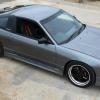QLD Whoretown...
Announcements
-
Similar Content
-
Latest Posts
-
By alburger87 · Posted
Hope your all having a mean Xmas! If anyone happens to know any trick to using the insanely complex climate control system, I cannot get it to not be on dual zone no matter how many times I deselect it (will say it's not but both vents blow different temps). Also one side is always hot, one always cold 🤷 -
By robbo_rb180 · Posted
I'd be looking at the mentioned EFR kit, room to turn it up if decide on e85 (which we know you will) and be super responsive and fun on the street. OR https://v8roadsters.com/product-category/engine-conversions/engine-conversion-lsx/engine-conversion-lsx-nc/?srsltid=AfmBOorrJa2S76JR5ekXprxBOtU44a1UProbe64YaiVi9zTVp1Lj814w And add whooshy noise for extra fun C5 corvette prices are coming down locally here and a mate has a manual one and is a heap of fun on the street and track. -
By joshuaho96 · Posted
I have an Elite 2500, honestly most of this has been a lot of smaller tasks chasing little details and a whole lot of life getting in the way of bigger projects. I don't mind too much looking at a spectrograph vs having audio knock ears. -
Nah nah nah nah. Don't do it. It's not all about the full throttle power delivery. The main "street fun" and drivability gains from smaller rear (in this case) is how you will have boost available from a low rpm when yo just roll onto the throttle. Think jinking in and out of traffic, coming out of roundabouts, etc etc, where you just want to roll onto the throttle a little and have the spooly noise from ~2000rpm and a swell of torque. More of what you've already achieved by going to 2.5. And then, towards the tail end of 2025 you can pull the turbo 4 out and put in a V8 like we originally suggested. :P
-








Recommended Posts